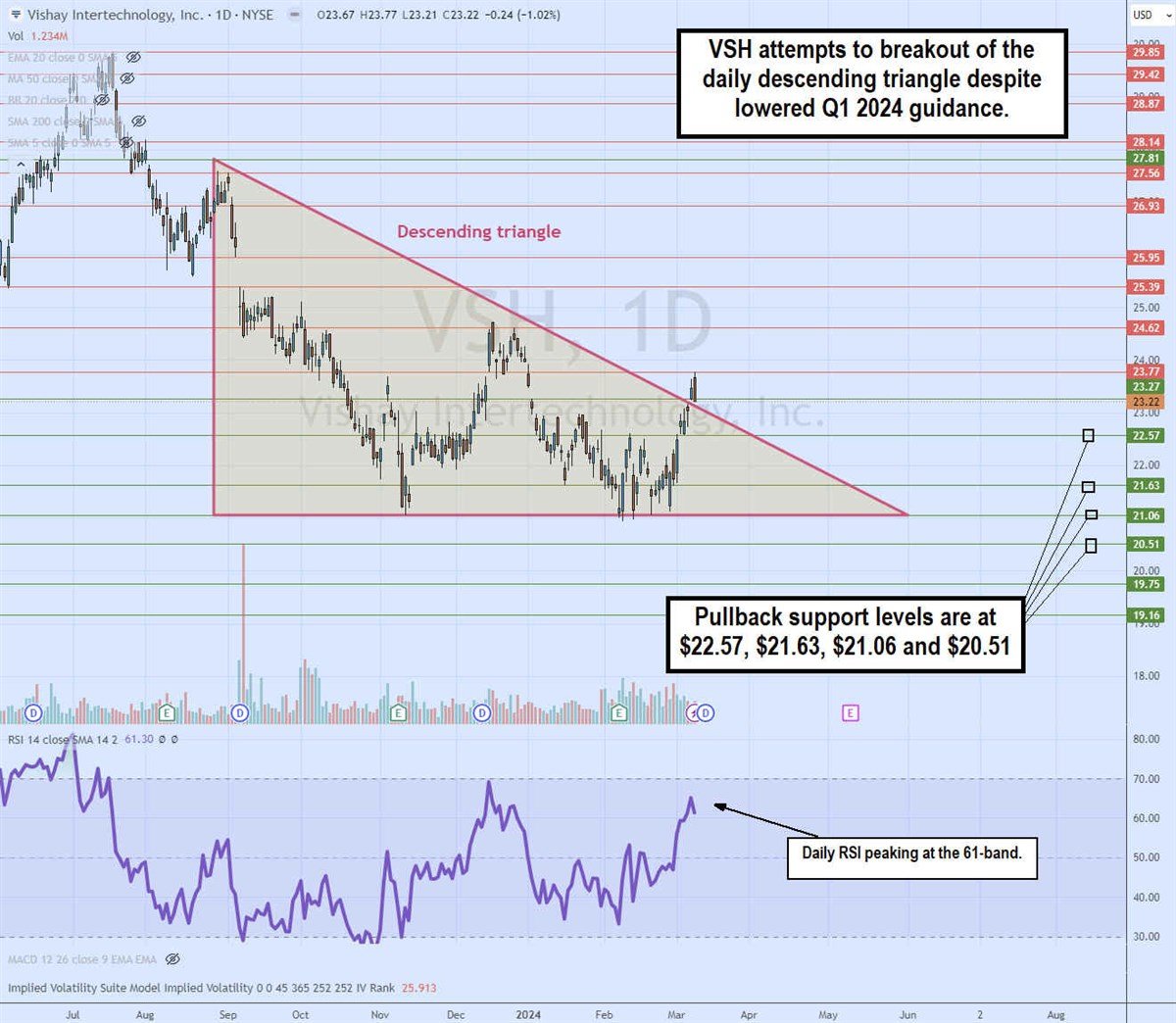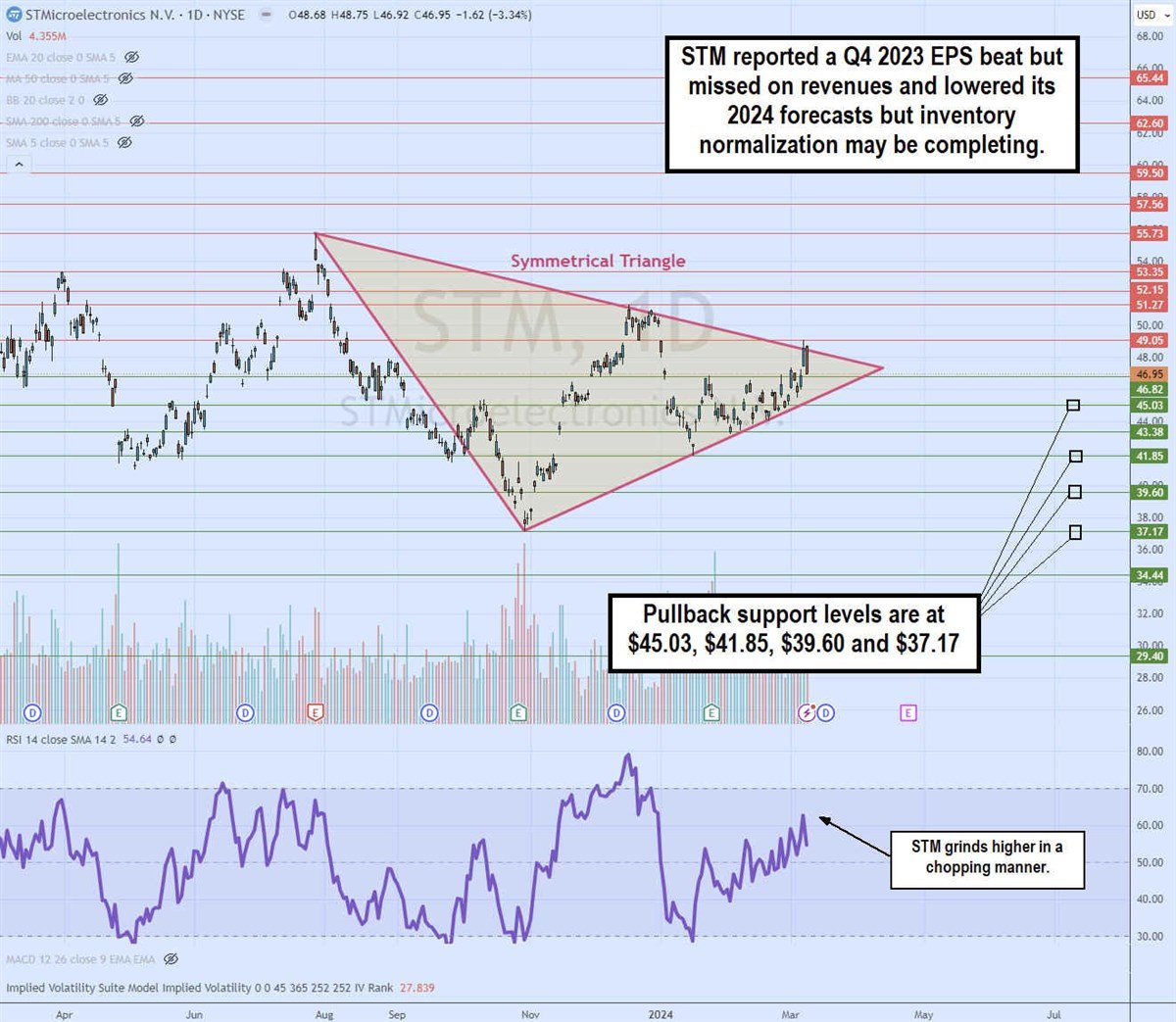![]()
Key points
- Vishay Intertechnology is a global manufacturer of discrete semiconductors and passive electronic components for automotive, industrial and consumer electronics.
- Vishay works with original equipment manufacturers (OEMs), including Tesla, Apple, Honeywell, LG Electronics, Sony and Medtronic.
- STMicroelectronics’ discrete semiconductors can be found in Internet of Things (IoT) sensors for solar panels and electric vehicles (EVs), indicating that the catch-up of discrete semiconductors could be a story in the second half of 2024.
- 5 stocks we like best from Vishay Intertechnology
Semiconductor stocks are rising thanks to the artificial intelligence (AI) boom driven by Nvidia Co. NASDAQ:NVDA AND Advanced Micro Devices Inc. NASDAQ:AMD. The VanEck Semiconductor ETF is up 28.66% year to date (YTD). It’s hard to find a group of semiconductors in the computing and technology sector that are still considered moderately cheap, unless they are significantly underperforming or frankly boring. Remember that most people assume that semiconductors are all computer chips, considered integrated circuits (ICs), or microchips containing multiple electronic components that include capacitors, transistors, and resistors integrated into a single silicon wafer.
What are discrete semiconductors?
Discrete semiconductors are individual electronic components that perform specific electronic functions such as controlling and amplifying electrical currents or voltages and switching circuits.
Passive electronic components do not require a power source and do not amplify or control electronic signals but store, filter, or regulate electrical energy like capacitors and resistors. Here are two discrete semiconductor stocks that are both underperforming and a bit dull, but which may have reached the bottom of their normalization cycle.
Vishay Intertechnology
Vishay Intertechnology Inc. New York Stock Exchange: VSH appears to have one of the largest semiconductor portfolios in the world, supplying electronic components to various end markets, from industrial to automotive. Their semiconductors include metal oxide semiconductor field-effect transistors (MOSFETs) used to switch and amplify electronic signals, diodes, and optoelectronic components.
OEM customers of major brands
They also have inductors and capacitors as passive electronic components that manage electrical energy flows. Their components are used in 5G and Internet of Things (IoT) networks. Their original electronics manufacturer (OEM) customer network reads like a who’s who in technology, automotive, healthcare, consumer electronics, industrial, including companies like The Apple company. NASDAQ:AAPL, Tesla Inc. NASDAQ:TSLA, Sony Co. NYSE: SNE, Medtronic plc New York Stock Exchange: MDT AND Honeywell International Inc. NASDAQ: HONOR.
Normalization
On February 7, 2024, Vishay reported EPS of 37 cents, beating consensus estimates of 36 cents by one cent. Revenue fell 8.2% year-over-year to $785.24 million from $787.15 million. The book-to-bill ratio was 0.75, with a backlog at the end of the quarter of 5.3 months. The company forecast first-quarter 2024 revenue of $715 million to $755 million, up from $795.1 million.
Comments from the CEO
Joel Smejkal, CEO of Vishay Intertechnology, commented: “For the fourth quarter, trends related to inventory adjustments, contracting lead times and softening demand in industrial end markets have become more evident. As customers continue to digest higher inventory levels, we have implemented our strategy to expand participation with our distribution partners.”
Smejkal concluded: “During this inventory adjustment period, our strong balance sheet and liquidity provide us with the resources to continue investing in incremental capacity and prepare Vishay for long-term demand trends in electric mobility, sustainability and connectivity .
Shares of peers and competitors of Vishay Intertechnology can be found with MarketBeat Stock Screener.

Daily descending triangle
The daily candlestick chart on VSH illustrates a descending triangle pattern. The descending trendline started at $27.81, limiting bounces at lower highs towards the flat-bottomed lower trendline at $21.06.
The fourth-quarter 2023 earnings report helped set the stage for a rally that is attempting to break out of the declining trend line at $23.22. The daily relative strength index is stalling in the 61 band. The pullback support levels are at $22.57, $21.63, $21.06, and $20.51.
STMicroelectronics
STMicroelectronics NV New York Stock Exchange: STM supplies automotive microchips and discrete semiconductors. Its components can be found in all consumer electronics and computer peripherals. STM provides semiconductors essential to clean energy, solar, electrification and automotive digitalization trends. Its discrete semiconductors are found in a wide range of low-power, high-performance industrial sensors used in IoT and pressure sensors for hermetic and waterproof applications. Obtain AI-powered insights on MarketBeat.
Q4 2023 EPS estimate exceeded but revenue missed
STM reported fourth-quarter 2023 EPS of $1.14, beating consensus analyst estimates of 95 cents by 19 cents. Revenue fell 3.2% year over year to $4.28 billion versus $4.31 billion. Gross margin was 45.5% and operating margin was 23.9% on net income of $1.08 billion. Full-year 2023 net revenue was $17.29 billion with a gross margin of 47.9% and an operating margin of 26.7% on net income of $4.21 billion.
Forward guide lowered
STM issued a downward forecast for first-quarter 2024 revenues of $3.6 billion versus consensus estimates of $4.08 billion. Gross margin is expected to be around 42.3% plus or minus 200 basis points. Full-year 2024 revenue is expected to be between $15.9 million and $16.9 million versus consensus estimates of $17.29 billion, with a gross margin of 40% to 40%.
CEO Insights
Fabio Sandri, CEO of Pilgrim’s Pride, noted that 2023 was a challenging year, but that they were able to drive growth under the most challenging circumstances. The affordability and availability of chicken have found favor with its customers. The company worked closely with key retail and foodservice clients to increase traffic through promotions.
The company has completed customer access to its hatchery and feed mill in Merida, with production expected to begin in March 2024. Sandri commented: “Going forward, we will expand the distribution of our existing innovation through retail and Further diversifying our foodservice portfolio will be critical to driving continued growth. Our investments in people over the past few years have resulted in adequate net staffing and reduced turnover levels across all of our U.S. facilities.”
STMicroelectronics analyst ratings and price targets I’m on MarketBeat.

Daily symmetrical triangle
The daily candlestick chart on STM indicates a symmetrical triangle pattern of lower highs and higher lows as it approaches the apex point. The closer the STM gets to the top, the narrower the range will be and, eventually, a breakout or breakdown will be triggered. The daily RSI moved upwards, but very unstablely, quickly peaking and then recovering. Support areas for the pullback are located at $45.03, $41.85, $39.60, and $37.17.
Before you consider Vishay Intertechnology, you’ll want to hear this.
MarketBeat tracks daily Wall Street’s highest-rated and best-performing research analysts and the stocks they recommend to their clients. MarketBeat identified the five stocks that top analysts are quietly whispering to their clients to buy now before the broader market takes hold… and Vishay Intertechnology wasn’t on the list.
While Vishay Intertechnology currently has a “hold” rating among analysts, top analysts believe these five stocks are better buys.
View the five stocks here
What stocks are being purchased by major institutional investors, including hedge funds and endowments, in today’s market? Click the link below and we’ll send you MarketBeat’s list of thirteen stocks that institutional investors are buying as fast as they can.
Get this free report